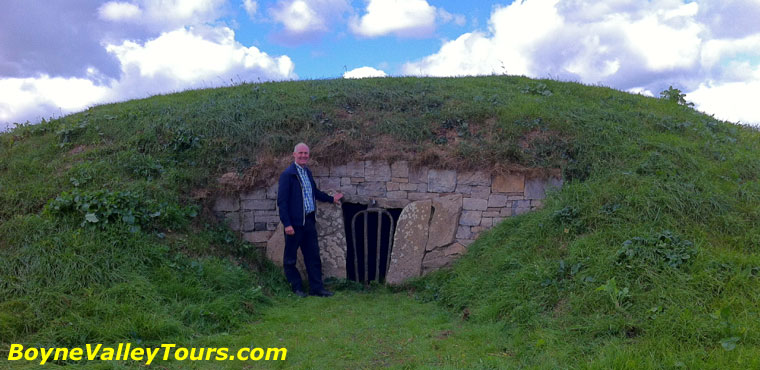Hill of Tara

Hill of Tara | Ancient ceremonial site and the traditional seat of the High Kings of Ireland.
The name Tara is from the Irish Teamhair meaning a 'sanctuary' or 'sacred space'. In the 12th century Dindsenchas (book of place names), the name Teamhair is recorded as the burial place of Tea, the daughter of Lugaid, Tara's first king.
According to the 11th century Leabhar Gabhála Éireann (The Book of Invasions), the Milesians sailed to Ireland and encountered the mythical Tuatha Dé Danann at Tara. Following a battle at nearby Tailtiu (Teltown), the Milesians emerged victorious, and the defeated Tuatha Dé Danann were forced into exile underground, where they are said to still exist as the Fairies.
Royal Place: 142 Kings reigned at Tara, Lia Fáil (Stone of Destiny) coronation stone.
Sacred Place: In mythology Tara was the dwelling place of the gods, an entrance to the Otherworld of eternal joy and plenty where no mortal every grew old.
Medieval scholars matched up the earthworks on Tara with the legends and mythology, Modern archaeology is proving the medieval names which we still use today to be inaccurate to say the least.
Samhain: The Festival of Samhain which marked the beginning of the Celtic year was celebrated at Tara. The entrance passage to the Mound of the Hostages is aligned with the rising sun around Samhain. At Samhain the division between this world and the otherworld was at its thinnest, allowing spirits to pass through. At avoid harmful spirits, people wore costumes and masks to disguise themselves which is the origin of dressing up for Halloween.
The Banqueting Hall
It is said to be the great Banqueting Hall mentioned in the legends of the feasts at Tara, however this is a Ceremonial Entrance.The Rath of the Synods
Named as the place of the ecclesiastical synods held at Tara, it is a Celtic period site from about 200BC to 300AD, originally a ceremonial site with wooden buildings, it was later used as a residence.The British Israelites damaged the sites between 1899 and 1902 looking for the Ark of the Covenant.
The Fort of the Kings - Rath na Rí
Build about 2000 years ago, it is a Ritual Enclosure with a circumference of 1km.The Mound of the Hostages
• Megalithic passage tomb 2,500 BC.• Named after King Niall of the Nine Hostages who kept hostages from subject kings in Ireland and Britain.
• 28 O'Neill kings rules at Tara from 400AD to 1022AD.
The Kings Seat - Forradh
• An unexcavated burial mound, build over in the early centuries AD.• The Lia Fáil (Stone of Destiny) is the inauguration stone of the Kings of Tara. Brought by the Tuatha Dé Danann (a mythical Irish tribe), it was said to roar when touched by the rightful king of Tara.
Teach Cormaic (Cormac's House)
• 7th to 10th century ring fort.• Named after the legendary King Cormac Mac Art who reigned from 220AD to 260AD. His reign was the golden age of plenty, he is credited with composing the ancient Brehan Laws.
The Church
• Present Church and churchyard wall build in 1822.• A small section of masonry lying on its side is all that remains of a 13th Century.
• There are two standing stones in the churchyard, on the taller stone has a sheela-na-gig or fertility goddess figure carved in relief.

